- CRISPR interference reagents
- CRISPRi All-in-one Lentiviral sgRNA
CRISPRmod CRISPRi All-in-one Lentiviral sgRNA
dCas9-SALL1-SDS3 and sgRNA expression from a single vector for simplified delivery in human
- Easy, ready-to-use lentiviral particles (thaw virus, add to cells)
- Single transduction = shorter time to results
- Ideal for difficult to transfect cells and low passage cells
- Enrich with either puromycin resistance or EGFP fluorescence
- Transduction-ready vectors eliminate cloning and in vitro transcription steps

1Start Here
2Choose
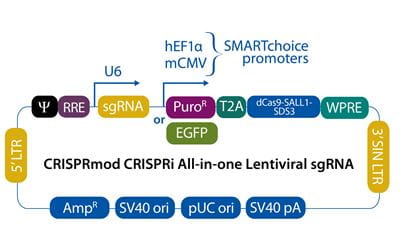
Easily generate a stable cell line repressing your gene of interest with the CRISPRmod CRISPR interference (CRISPRi) system. This system is a unique adaptation of the classical CRISPR-Cas9 gene editing system which utilizes a catalytically deactivated Cas9 (dCas9) that is fused to repressor domains (SALL1 and SDS3). When paired with a well-designed guide RNA that targets a gene near its promoter region or transcriptional start site (TSS) it reduces transcription.
The choice of a puromycin resistance gene or EGFP marker allows for selection of cells that have successfully integrated the vector. The EGFP selection marker is recommended for rapid enrichment of edited cells, as FACS analysis may be performed as soon as fluorescence is expressed. This is especially useful for short-lived cell types, such as primary cells.
The predesigned All-in-one CRISPRi Lentiviral sgRNAs are available as:
- High quality, concentrated, purified lentiviral particles for direct transduction with minimal cytotoxicity; delivered at titers of ≥ 1 x 107 TU/mL
- Designs optimized from a published algorithm by Horlbeck, et. al. demonstrate strong levels of gene repression (see References tab)
- For genes with alternative characterized start sites, distinct guide RNA designs are available (labeled P2).
Review our CRISPRi application page and the AIO application page to get an overview of the technology.
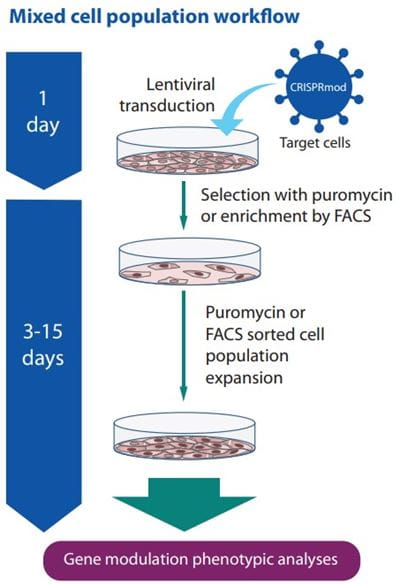
CRISPR modulation all-in-one lentiviral workflow image
CRISPRi All-in-one Lentiviral sgRNA controls
CRISPRi All-in-one Lentiviral sgRNA Positive Controls
- All-in-one lentiviral sgRNAs targeting well-characterized genes to determine the effectiveness of your experimental conditions for maximum transcriptional repression.
CRISPRi All-in-one Lentiviral sgRNA Non-targeting Controls
- Bioinformatically designed All-in-one Non-targeting sgRNA controls to evaluate baseline cellular responses to CRISPRi components in the absence of target-specific sgRNA.
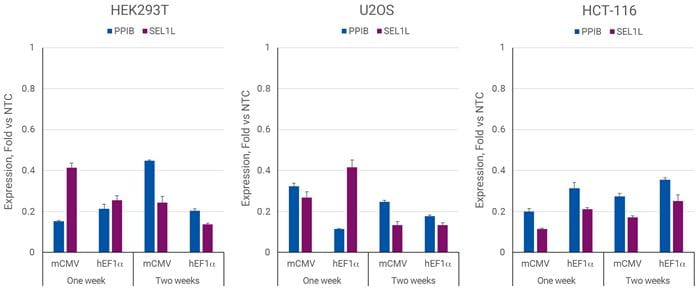
Transcriptional Repression with CRISPRmod All-in-one Puro-dCas9-SALL1-SDS3
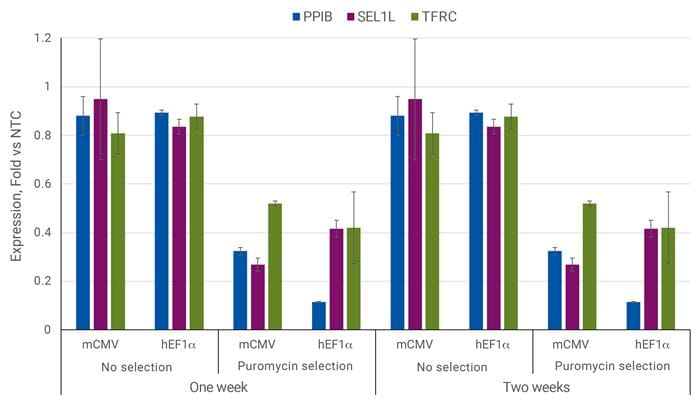
Selection markedly improves transcriptional repression in U2OS cells
- M. A. Horlbeck et al., Compact and highly active next-generation libraries for CRISPR-mediated gene repression and activation. eLife. 5, e19760 (2016).
LentiBOOST Lentivirus Transduction Enhancer is a uniquely formulated transduction reagent that can be used with or without lentivirus spinfection in order to increase successful viral transduction events while preserving cell viability. Especially critical for preserving precious primary cells from patient cohorts, or, for engineering complex animal models; improving transduction efficiency can save time and costs by increasing the success of each editing/transduction step, or, even avoid the loss of irreplaceable samples. Additionally, LentiBOOST technology is already used in the manufacturing of a number of clinical stage therapies providing the opportunity to demonstrate improved workflow applicability to the clinic.
LentiBOOST can be purchased through the Dharmacon Reagents catalog.
To learn more about LentiBOOST technology visit the Revvity LentiBOOST webpage.
Supporting Data
Improved CD8+ T-cell SMARTvector™ shRNA lentiviral system transduction using LentiBOOST™ Lentivirus Transduction Enhancer
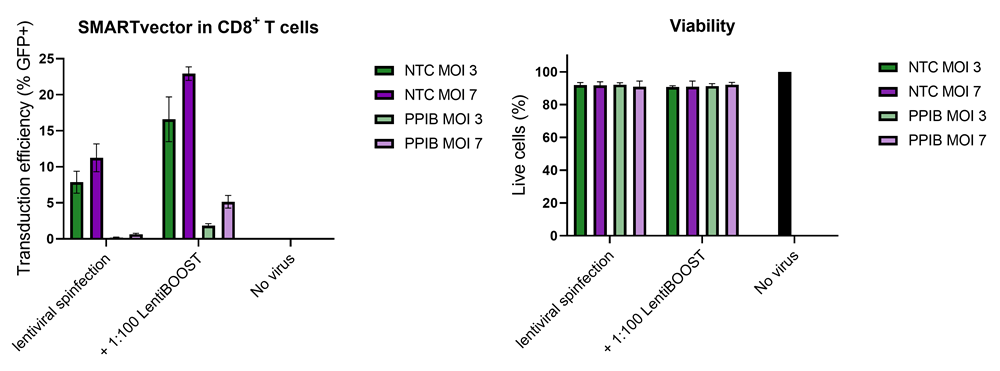
100,000 primary human CD8+ T cells were transduced with either 30,000 (MOI 3, green) or 70,000 (MOI 7, purple) TUs of SMARTVector™ mCMV tGFP Lentiviral Control Particles targeting either NTC or PPIB along with 1:100 LentiBOOST transduction enhancer. Cells were centrifuged at 800 x g for one hour at 32 °C followed by a four hour incubation prior to removal of lentiviral particles and transduction enhancer. Transduction efficiency (%GFP+ out of live cells) and viability were determined 5 days post-transduction by flow cytometry. The addition of LentiBOOST technology markedly improved transduction efficiencies without significantly impacting cell viability.
Improved CD4+ and CD8+ T-cell Edit-R™ All-in-one sgRNA/Cas9 lentiviral system transduction using LentiBOOST™ Lentivirus Transduction Enhancer
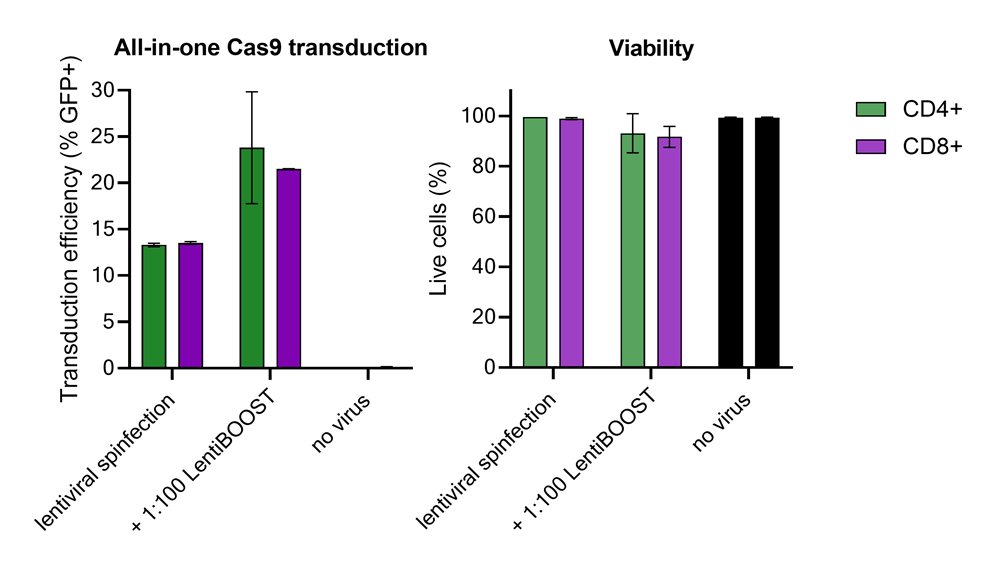
100,000 primary human CD4+ and CD8+ T cells from two donors were transduced with 250,000 TUs of Edit-R GFP Delivery controls mCMV along with 1:100 LentiBOOST transduction enhancer. Cells were centrifuged at 800 x g for one hour at 32 °C followed by an overnight incubation prior to removal of lentiviral particles and transduction enhancer. Transduction efficiency and viability were determined 72 hours post-transduction by flow cytometry. The addition of LentiBOOST technology markedly improved transduction efficiencies without significantly impacting cell viability.
Improved transduction of human induced pluripotent stem cells (hiPSCs) with the Strict-R™ Inducible CRISPRa lentiviral system transduction using LentiBOOST™ Lentivirus Transduction Enhancer

10,000 WTC hiPS cells were transduced with either 20,000 (MOI 2, green) or 40,000 (MOI 4, purple) TUs of Strict-R™ Inducible EGFP dCas9-VPR Lentiviral Particles along with 1:100 LentiBOOST transduction enhancer. Cells were centrifuged at 800 x g for one hour at 32 °C followed by an overnight incubation prior to removal of lentiviral particles and transduction enhancer. Transduction efficiency and viability were determined 72 hours post-transduction by flow cytometry. The addition of LentiBOOST markedly improved transduction efficiencies without significantly impacting cell viability.
Product inserts
Safety data sheets
Selection guides
Related Products
All-in-one non-targeting constructs are bioinformatically designed and validated to not target any gene in human or mouse genomes.
Validated CRISPRmod CRISPRi All-in-one lentiviral sgRNA positive controls used to establish activity of CRISPR interference in a cell type of interest.
LentiBOOST transduction enhancer can increase successful viral transduction in challenging to transduce cells, or, complex cellular engineering work; while preserving cell viability and minimizing the amount of viral particles required for your experiment. LentiBOOST technology is actively used in the production of clinical stage lentivirally delivered therapies, including some approved therapies, providing a direct path to therapeutic applicability for your research studies. Tested with Dharmacon Lentiviral reagents.
Perform repression of thousands of genes at the transcriptional level with a single transduction of CRISPRi all-in-one pooled lentiviral library eliminating the need to perform sequential transductions.
